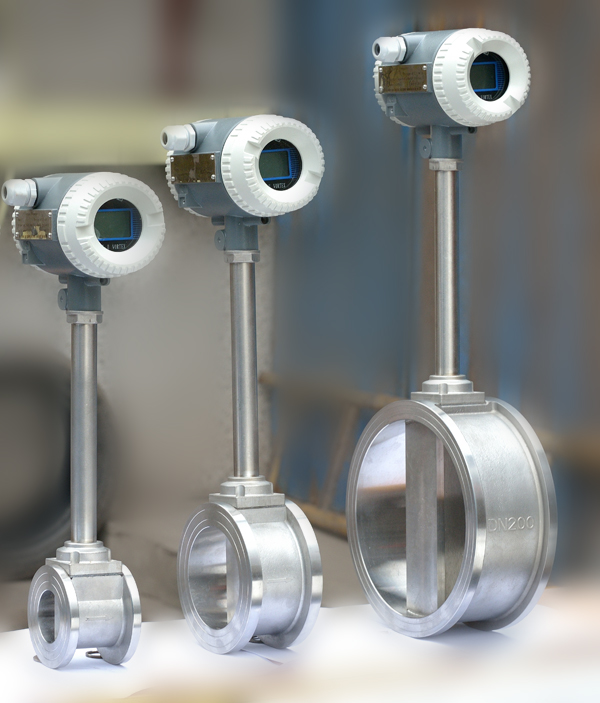Working Principle:
Vortex flow meter is a volumetric flowmeter that measuresthe volumetric flow of gases, vapors, or liquids, nominal volumetric flow ormass flow, based on Karman’s vortex principle. The principle of the vortexflowmeter is to use piezoelectric stress sensors with high reliability and canwork in the operating temperature range of -20°C to +250°C. There are analogstandard signals and digital pulse signals output. It is easy to use withdigital systems such as computers. It is a relatively advanced and idealmeasuring instrument. According to different media and different environments,there are many types of options we can choose, such as steam vortex flowmeters,insertion vortex flowmeters, and pipeline vortex flowmeters.

Product Features:
△ No moving parts, long-term stability,simple structure, easy installation and maintenance;
△ The sensor output is pulse frequency, itsfrequency is linear with the actual flow of the fluid under test, the zeropoint has no drift, the performance is very stable, the structure is various,there is a pipeline type, plug-in flow sensor form;
△ High accuracy, usually liquid measurementaccuracy is ± 1.0%; gas measurement accuracy is ± 1.5%;
△ Measurement range is wide, in the rangeof 2104 ~ 7106 Reynolds number, up to 120;
△ small pressure loss (about 14 to 12orifice flowmeter), belonging to energy-saving flow meter;
△ The installation method is flexible,according to the site process piping is not accessible, can be installedhorizontally, vertically and at different angles;
△ Using the interference circuit andanti-vibration sensor head, it has certain resistance to environmentalvibration;
△Using ultra-low-power microprocessortechnology, 1 section of 3V10AH lithium battery can be used for more than 5years;
△ The software calibrates the non-linearcoefficient of the meter to improve the measurement accuracy;
△Use EEPROM to protect the accumulated flowfrom power-off. The protection time is more than 10 years.

Installation requirements:
1. Pipelines
The installation of the vortex flowmeterrequires a certain amount of front and rear straight pipe sections. The commonsituation is as follows (D is the diameter of the pipe):
|
Pipeline Condition |
upstream |
downstream |
|
Concentric tube, fully open valve |
15D |
5D |
|
90° right angle elbow |
20D |
5D |
|
Two 90° elbows angle in the same plane |
25D |
5D |
|
Half-opening valve, regulating valve |
50D |
5D |
|
Two 90° elbows angle in different planes |
40D |
5D |
|
With rectifier tube bundle |
12D |
5D |
2. Installation conditions
- The sensor should be mounted on a pipe withthe same diameter as the horizontal, vertical, and inclined (fluid flow frombottom to top). The upstream and downstream of the sensor should be equippedwith a straight pipe section of a certain length. The length of the straightpipe section must conform to the requirements for the straight pipe section 15to 20D and the straight pipe section 5 to 10D.
- The nearby pipeline where the liquid sensoris installed should be filled with the measured liquid.
- Sensors should not be installed on pipeswith strong mechanical vibrations.
- The inner diameter of the straight pipesection is as close as possible to the sensor diameter. If it is notconsistent, a pipe with a diameter slightly larger than the sensor should beused. The error should be ≤3% and does not exceed 5mm.
- Sensors should be installed in places withstrong electromagnetic interference, small space, and inconvenient maintenance.

SichuanVacorda Instruments Manufacturing Co., Ltd
21 Years FocusedonLevel MeasurementinExtremeProcessConditions
Tel: +86 28 8701 3699
Email: sales@vacorda.com
Web: www.vacorda.com
Post time: 21-09-21
